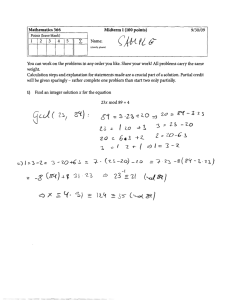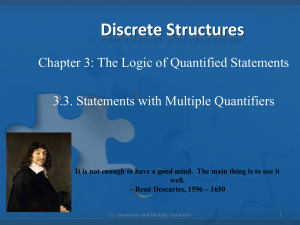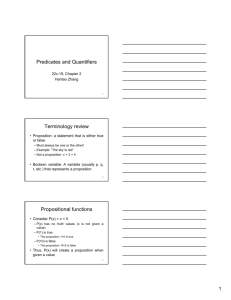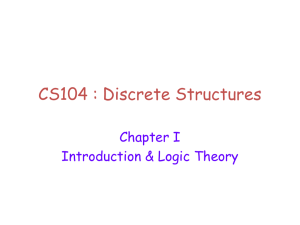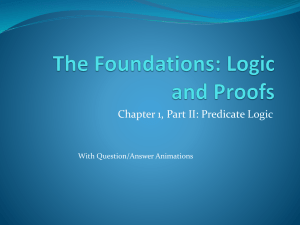CS173: Discrete Math
advertisement
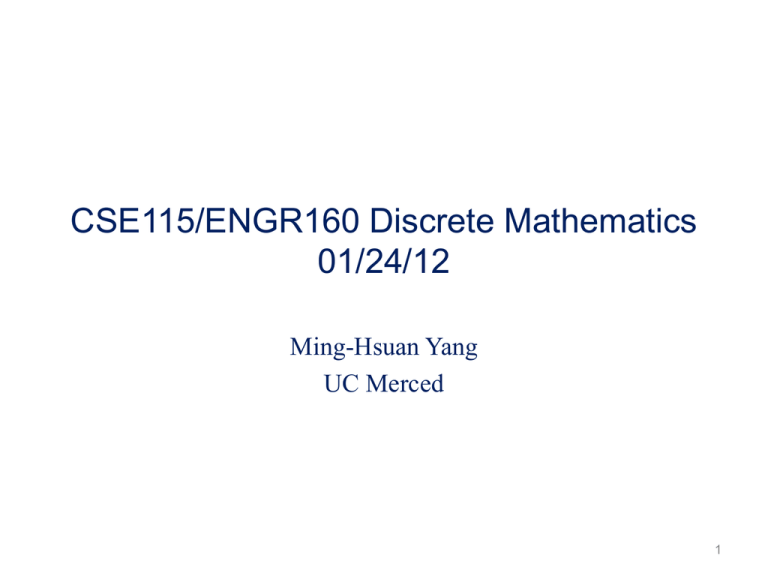
CSE115/ENGR160 Discrete Mathematics
01/24/12
Ming-Hsuan Yang
UC Merced
1
Logical equivalences
• S≡T: Two statements S and T involving
predicates and quantifiers are logically
equivalent
– If and only if they have the same truth value no
matter which predicates are substituted into these
statements and which domain is used for the
variables.
– Example: x( p( x) q( x)) xp( x) xq( x)
i.e., we can distribute a universal quantifier
over a conjunction
2
x( p( x) q( x)) xp( x) xq( x)
• Both statements must take the same truth
value no matter the predicates p and q, and
non matter which domain is used
• Show
– If p is true, then q is true (p → q)
– If q is true, then p is true (q → p)
x( p( x) q( x)) xp( x) xq( x)
x( p( x) q( x)) xp( x) xq( x)
3
x( p( x) q( x)) xp( x) xq( x)
x( p( x) q( x)) xp( x) xq( x)
• (→) If a is in the domain, then p(a)˄q(a) is
true. Hence, p(a) is true and q(a) is true.
Because p(a) is true and q(a) is true for every
element in the domain, so xp( x) xq( x)
is true
• (←) It follows that xp( x) and xq( x) are
true. Hence, for a in the domain, p(a) is true
and q(a) is true, hence p(a)˄q(a) is true. If
follows x( p( x) q( x)) is true
4
Negating quantified expressions
Negations of the following statements
“There is an honest politician”
“Every politician is dishonest”
(Note “All politicians are not honest” is ambiguous)
“All Americans eat cheeseburgers”
5
Example
Whatare thenegationsof x( x 2 x) and x( x 2 2) ?
x ( x 2 x )
x( x 2 2)
x( x 2 x )
x( x 2 2)
x ( x 2 x )
x( x 2 2)
Show x( p( x) q( x)) x( p( x) q( x))
x( p( x) q( x)
x(( p( x) q( x)))
x((p( x) q( x)))
x( p( x) q( x))
6
Translating English into logical
expressions
• “Every student in this class has studied
calculus”
Let c(x) be the statement that “x has studied
calculus”. Let s(x) be the statement “x is in
this class”
x c( x) if thedomain consistsof studentsof thisclass
x s( x) c( x) if thedomain consistsof all people
x s( x) c( x) ? if thedomain consistsof all people
7
Using quantifiers in system
specifications
• “Every mail message larger than one
megabyte will be compressed”
Let s(m,y) be “mail message m is larger than y
megabytes” where m has the domain of all
mail messages and y is a positive real number.
Let c(m) denote “message m will be
compressed”
m( s(m,1) c(m))
8
Example
• “If a user is active, at least one network link
will be available”
Let a(u) represent “user u is active” where u
has the domain of all users, and let s(n, x)
denote “network link n is in state x” where n
has the domain of all network links, and x has
the domain of all possible states, {available,
unavailable}.
u a(u) n s(n, available)
9
1.5 Nested quantifiers
Let the variable domain be real numbers
xy ( x y) 0
same as xq( x)
where q( x) is yp( x, y ) and p( x, y) is x y 0
xy ( x y y x)
xyz ( x ( y z ) ( x y) z )
xy ((x 0) ( y 0) ( xy 0))
where the domain for these variables
consists of real numbers
10
Quantification as loop
• For every x, for every y
xyp( x, y )
– Loop through x and for each x loop through y
– If we find p(x,y) is true for all x and y, then the
statement is true
– If we ever hit a value x for which we hit a value for
which p(x,y) is false, the whole statement is false
• For every x, there exists y
xyp( x, y)
– Loop through x until we find a y that p(x,y) is true
– If for every x, we find such a y, then the statement is
true
11
Quantification as loop
• xyp( x, y) : loop through the values for x until
we find an x for which p(x,y) is always true
when we loop through all values for y
– Once found such one x, then it is true
• xyp( x, y) : loop though the values for x
where for each x loop through the values of y
until we find an x for which we find a y such
that p(x,y) is true
– False only if we never hit an x for which we never
find y such that p(x,y) is true
12
Order of quantification
Let p( x, y ) be thestatementx y y x,
and thedomain is real number
xyp( x, y )
xyp( x, y ) yxp( x, y ) ?
Let q( x, y ) be thestatementx y 0,
and thedomain is real number
yxq( x, y ) : T hereis a real number y s.t.for everyreal number x, q(x,y)
xyq( x, y) : For everyreal number x thereis a real number y s.t.q(x,y)
yxp( x, y ) xyp( x, y ) ?
13
Quantification of two variables
14
Quantification with more variables
Let q( x, y, z ) be thestatementx y z,
and thedomain is real number
xyzq ( x, y, z ) : Whatdoes it mean?Is it true?
zxyq( x, y, z ) : Whatdoes it mean?Is it true?
15
Translating mathematical
statements
• “The sum of two positive integers is always
positive”
xy ((x 0) ( y 0) ( x y 0))
where thedomain for both variables consistsof
all integers
xy ( x y 0)
where thedomain for both variables consistsof
all positiveintegers
16
Example
• “Every real number except zero has a
multiplicative inverse”
x((x 0) y ( xy 1))
where thedomain for both variables consistsof real numbers
17
Express limit using quantifiers
Recall lim f ( x ) L
xa
For every real number ε>0, there exists a real
number δ>0, such that |f(x)-L|<ε whenever
0<|x-a|<δ
x(0 | x a | | f ( x) L | )
where thedomain for and is positivereal number,
and thedomain for xis real number
0 0x(0 | x a | | f ( x) L | )
where thedomain for , , and x, is real number
18
Translating statements into English
• x(c( x) y(c( y) f ( x, y))) where c(x) is “x has
a computer”, f(x,y) is “x and y are friends”, and
the domain for both x and y consists of all
students in our school
• xyz(( f ( x, y) f ( x, z) ( y z)) f ( y, z))
where f(x,y) means x and y are friends, and
the domain consists of all students in our
school
19
Negating nested quantifiers
xy ( xy 1)
xy ( xy 1)
xy( xy 1)
xy ( xy 1)
• There does not exist a woman who has taken
a flight on every airline in the world
waf ( p( w, f ) q( f , a))
waf (p( w, f ) q( f , a))
where p(w,f) is “w has taken f”, and q(f,a) is “f
is a flight on a
20
